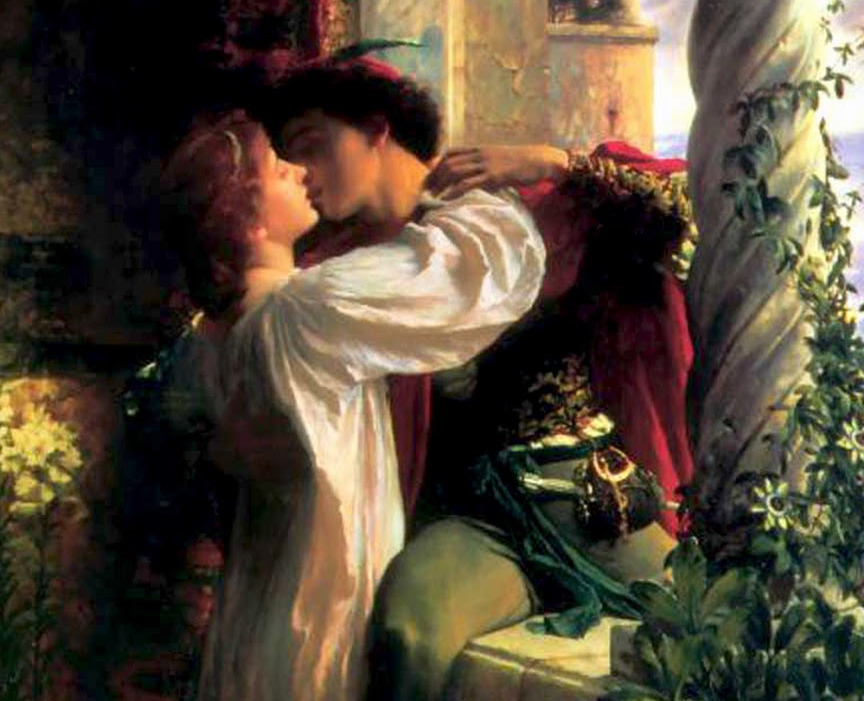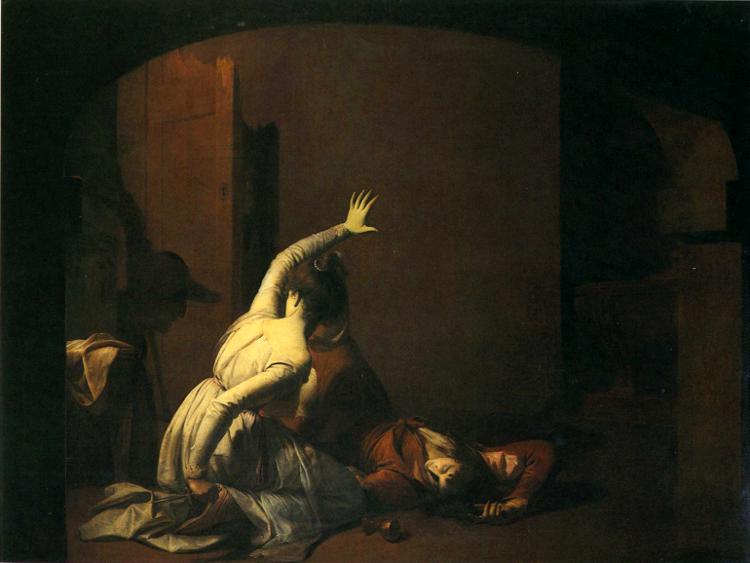Adrienne L. Eastwood, Ph.D
Professor of English & Comparative Literature
San Jose State University
When William Shakespeare sat down to work on Romeo and Juliet, the story he decided to tell was hardly original. Tales of star-crossed lovers had been told and retold for centuries. The Celtic legend of Tristan and Iseult, Virgil’s Aeneas and Dido, Chaucer’s Troilus and Criseyde—all follow similar plot lines: forbidden love leading to tragic death. But something about Shakespeare’s version not only eclipses those earlier fictions, but establishes these two youths as the iconic representations of romantic love for all ensuing centuries. Shakespeare’s play, known around the world, has inspired countless stage productions, an opera, a ballet, musicals, and television adaptations.

Romeo and Juliet by Frank Bernard Dicksee 1884.
And one doesn’t need to have seen any of these productions or read Shakespeare’s play to know the ubiquitous characters; we find them all around us–referenced in popular music, anime, video games, cartoons, and even children’s toys.
It is not clear what accounts for the industry that has been built up around this play written over 400 years ago, but something about Shakespeare’s text continues to captivate audiences. Perhaps the innovation was Shakespeare’s choice to follow Arthur Brooke’s long narrative poem The Tragical History of Romeus and Juliet (1562) that served as his main source, and to use a rivalry between two noble families as the backdrop for the story rather than a war or some other device. The feud, the cause of which neither the poet nor the playwright explains, heightens the pointless nature of the violence, and thus the tragic deaths of the two lovers. But while the feud is an important device, most scholars agree that in transforming the long, dark, and somewhat didactic poem into a stage play, Shakespeare’s main innovation is to add a generic twist to the story, inserting comedic elements into the tragic arc. The characters of Mercutio and the Nurse are filled out and full of bawdy commentary and word play, and the first three acts are, in fact, structured like a comedy, with the initial disorder experienced by the two youths resolved by their clandestine marriage in the third act. However, with the death of Mercutio in 3.1, the play resumes its course to the expected tragic conclusion.
But Shakespeare’s flirtation with comedy as he tells this tale of doomed love doesn’t adequately explain the enduring popularity of these characters or this story. In fact, Shakespeare would doubtless have been puzzled by the fascination subsequent generations seem to have with his characters, since he was less interested in the lovers themselves than he was in using them to experiment with the function of language, and perhaps even to explore its power to fashion the idea of romantic love in the imaginations of his audience.
Writing as he was for the Elizabethan stage, where they relied on natural light, few stage effects, limited visibility, and all of the parts—including that of Juliet—were played by men, Shakespeare knew that the images he could draw with his poetry were by far the most effective means to arouse emotion in his audience. Juliet would naturally be compared to the torches that lit up the stage, but Shakespeare recognized that in order to really sell her beauty, she would need to not just outshine them, but to “teach them to burn bright” (1.5). In the famous balcony scene, Romeo sees the light shining from Juliet’s window, and this makes him compare her to the sun, who is so beautiful that she makes the moon jealous: “It is the East, and Juliet is the sun. / Arise, fair sun, and kill the envious moon, / Who is already sick and pale with grief / That thou, her maid, art more fair than she” (2.3). Shakespeare’s language does more than simply create the scene: it fires the imaginations of his audience and convinces them that what they are seeing is real. Day becomes night, the stage becomes a garden, and the bodies we see on stage are young and excited by the feeling of new love. The soaring and gorgeous poetry follows the pair through all five acts of the play and stays with the audience long after its conclusion.

Romeo and Juliet, The Tomb Scene by Joseph Wright of Derby, 1790.
Of course, many of Shakespeare’s plays contain vivid and beautiful poetry. But what sets Romeo and Juliet apart is the playwright’s insistence on exploring the myriad ways in which words are able to make—and also fail to make—meaning. The play is full of references to books, words, and names, conveying the playwright’s preoccupation with his craft, and with the miracle that, given the complexities of spoken language, anyone ever manages to accurately communicate anything. The opening scuffle between the Montague and Capulet houses contains more word play than sword play, and almost every character
indulges in puns—a form of humor that depends on the instability of language. In the balcony scene, that linguistic volatility is applied to family names as Juliet famously wonders, “What is in a name?” She wishes that the names Capulet and Montague could become empty, free-floating signifiers, leaving the lovers unburdened. Romeo’s response shifts the focus slightly to the mechanics of writing itself, telling her that if his name were written down on a piece of paper, he would “tear the word” (2.2). Whether it’s slippery signifiers or the technologies of literacy itself, there are too many references to ignore how language is at work in this text. When Prince Escalus scolds the men for disturbing the peace of Verona with their “civil brawls,” he notes that these arguments were “bred of an airy word” (1.1.84). This phrase begs the question, if something as seemingly unsubstantial as an “airy word” can bring about bloodshed in the streets, what else might words do? In the hands of a skilled playwright like Shakespeare, the answer seems to be that they can create a scene, build a character, and conjure ideas and emotions in the minds of his audience.
Poetic language, it seems clear, was elemental to the theatrical experience in Shakespeare’s time, but it is really the intersection between language and imagination that creates the magic that comprises that theatrical experience. In A Midsummer Night’s Dream, which was written and performed at the same time as Romeo and Juliet and is considered its companion play, Shakespeare makes the power of language to evoke images in the imagination one of the central thematic elements. This play, which Shakespeare appears to have invented from whole cloth without any source material, is an exercise in metatheatricality. One of the four plots follows a troupe of bumbling, amateur players as they rehearse, and eventually perform, their version of Pyramus and Thisbe (yet another story of tragic love) for the nobles gathered to celebrate the multiple marriages that conclude the play. In act 4 scene 2, Peter Quince, the director and playwright for this rag-tag troupe (and comic stand in for Shakespeare himself) is hailed by the lone player who seems interested in acting, Bottom the Weaver, as the only one who would be able to transform his “dream,” which he himself is unable to put into words, into a “ballad” that might then be performed before an audience. It is the playwright, of course, who can name the unnamable and turn nothing into something. In the following scene, Theseus (the Duke of Athens) muses aloud, “The poet’s eye, in a fine frenzy rolling, / Doth glance from heaven to earth, from earth to heaven; / And as imagination bodies forth / The forms of things unknown, the poet’s pen / Turns them to shapes, and gives to airy nothing / A local habitation and a name” (5.1). The “airy word” in Romeo and Juliet becomes an “airy nothing” that only the imagination and the poet’s pen can turn into a work of meaningful art. Theseus’s observation evokes the magic of the theater, where performers convince audiences—at least for the “two hours traffic” across the stage—that the feelings and experiences they are going through as characters are important and true. Taken together, Romeo and Juliet and A Midsummer Night’s Dream show us what Shakespeare clearly knew: language and imagination have crucial roles to play in creating the magic of theater.
Since Shakespeare’s day, what constitutes the theatrical experience has expanded exponentially, and his plays have been translated into a hundred languages and performed all around the world. While stage plays have always been popular forms of entertainment, opera really began to flourish in the eighteenth and nineteenth centuries, and musicals, films, and television are, of course, dominant forms today. Though the forms have changed, the magic that constitutes the experience has not. Theater brings people from all cultures and walks of life together to share a story, and for a finite period of time, the things that divide us are forgotten as the words, lyrics, music, and our imaginations carry us along, reminding us of the things that we share in common as human beings. In many ways, Romeo and Juliet is emblematic of the theatrical experience, as the divisions between two families are healed by the story of their children. Rivalries and feuds keep people from connecting, but love has the ability to heal those rifts. Shakespeare’s tragic lovers still exist to remind people that love—what brings us together–should be more mighty than the hatred that tears us apart.
As you sit back and enjoy the beautiful music in Romeo et Juliette (1867) by Charles Gounod, and watch Shakespeare’s familiar story unfold, consider the temporal intersections at play, and the way our imaginations bridge them: A timeless story, reshaped by Shakespeare in the sixteenth century, transformed into an opera in the nineteenth century, and performed for an audience in the twenty-first century. Did Shakespeare ever dream of this level of time travel? And yet, here we are. Brought together once again to allow ourselves to be moved by this story, that at is core is about the destructive power of divisiveness and the healing power of love.